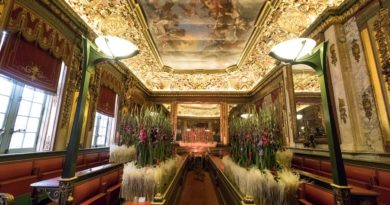Brussels stories – Fly over and bomb the Nazis
Brussels is a city of wonders and mysteries. Its streets, squares and buildings overflow with stories, anecdotes and curious facts about the city’s history and past, making it more interesting and lively and, in particular, creating strong connection between past and present.
Several statues scattered around Brussels remember significant moments, and some of them recall incredible stories. For instance, if you’ve ever walked in Avenue Louise, all the way up till Abbaye de la Cambre, you may have noticed a golden statue of a man’s head. The story behind that monument is quite unusual.
Commemorative bust of Baron Jean Selys de Longchamps in front of Avenue Louise 453. During WW2, this was the seat of the…
Publié par Lars Vos sur vendredi 21 octobre 2016
The statue represents the Baron Jean Michel P.M.G. de Selys Longchamps and the incredible mission he accomplished in the 1940s. The baron, born in 1912, was a native Belgian who started his career in the Belgian military in the 1st Guides Regimen, reaching the rank of cavalry officer in 1937. He took part to the conflict in Lanaken, Gette, and in Lys and left Belgium with the BEF from Dunkirk. Once in the UK, despite his age (28 years old at the time, way beyond the age limits imposed) he joined the RAF and became a pilot of the 609 Squadron, flying Hawker Typhoons. He quickly obtained military successes and reached higher ranks in the air force.
While in the RAF, the baron became familiar with a particular type of mission, called “Rhubarb”. This strategy consisted in a single or joint attack to an objective: one or two typhoons would fly over the English channel at a very low height, reach quickly the objective and bomb it from very close to the ground (as the name suggest, at “plants’ height”), to then rapidly fly back at a safer altitude.
On the 20th of January 1943, Jean Michel and a second pilot accomplished a mission in Ghent, bombing a train station: the second pilot returned to the base in England right away, but the baron moved to Brussels, to solve a personal pending issue. He flew over the city, passing the Palace of Justice, the Marolles area, the Royal Palace and the Cinquantenaire Park. He got closer and closer to the ground, moving at 200 km/h, and quickly arrived to its objective: the building number 453 in Avenue Louise, la “Résidence Belvédère”. Several reports and clandestine newspaper had confirmed in the previous weeks that the building had been occupied by Nazis, who made of it the Sicherheitspolizei and the Sicherheitsdienst (SiPo and SD) headquarters. The sources confirmed that the building was of particular interest because of its occupants and because of the atrocities they perpetrated inside: political prisoners and Jews were detained and tortured there, making of it a crucial target to conquer and neutralize.

Flying solo and without an explicit consent from his superiors (some affirm that he never even informed the higher ranks of his plan), Jean Michel moved forward and attack the building, bombing it and injuring several members of the Gestapo. After this insane act of courage, de Selys flew right back to England, without being attacked or menaced by the enemies’ air forces.
The baron’s personal Rhubarb mission, risky, sudden and extremely dangerous, costed him a retrocession to the rank of pilot officer, but it also honored his courage with the Distinguished Flying Cross.
The golden half-bust has been placed right in front of the Résidence Belvédère: it commemorates a man’s audacity and strong values, and it reminds the baron’s desires of both liberating his homeland and defeat a despicable enemy.



